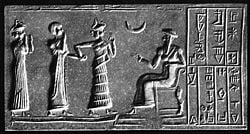Sin (mythology)
| Fertile Crescent myth series | |
|---|---|
| Mesopotamian | |
| Levantine | |
| Arabian | |
| Mesopotamia | |
| Primordial beings | |
| 7 gods who decree | |
| Demigods & heroes | |
| Spirits & monsters | |
| Tales from Babylon | |
| The Great Gods | |
|
Adad · Ashnan |
Template:Ancient Near East portal

|} Sin (Akkadian: Sîn, Suen; Sumerian:Nanna) is a Sumerian god in Mesopotamian mythology. He is the god of the moon and the son of Enlil and Ninlil. His sacred city was Ur. The name Nanna is Sumerian for "illuminator."
Background
Sin's chief sanctuary at Ur was named E-gish-shir-gal ("house of the great light"). His sanctuary at Harran was named E-khul-khul ("house of joys"). On cylinder seals, he is represented as an old man with a flowing beard and the crescent as his symbol. In the astral-theological system he is represented by the number 30 and the moon, symbolic of the moon's crescent that often appears next to him in Mesopotamian cylinder seals. This number probably refers to the average number of days (correctly around 29.53) in a lunar month, as measured between successive new moons.
The "wisdom" personified by the moon-god is likewise an expression of the science of astrology, in which the observation of the moon's phases is so important a factor. The tendency to centralize the powers of the universe leads to the establishment of the doctrine of a triad consisting of Sin, Shamash, and Ishtar, respectively personifying the moon, the sun, and the planet Venus.
He was named Sin in Babylonia and Assyria, and was also worshipped in Harran. Sin had a beard made of lapis lazuli and rode on a winged bull. His wife was Ningal ("Great Lady"), who bore him Utu ("Sun") and Inanna (Inanna is recognized as being the Sumerian name for Ishtar). His symbols are the crescent moon, the bull (through his father, Enlil, "Bull of Heaven"), and the tripod (which may be a lamp-stand). An important Sumerian text ("Enlil and Ninlil")[1] tells of the descent of Enlil and Ninlil (pregnant with Nanna/Suen) into the underworld. There, three "substitutions" are given to allow the ascent of Nanna/Suen. The story shows some similarities to the text known as "The Descent of Inanna."
Seats of Sin's worship
The two chief seats of Sin's worship were Ur in the south, and Harran to the north. The cult of Sin spread to other centers, and temples of the moon-god are found in all the large cities of Babylonia and Assyria.
He is commonly designated as En-zu, or "lord of wisdom." During the period (c.2600-2400 B.C.E.) that Ur exercised a large measure of supremacy over the Euphrates valley, Sin was naturally regarded as the head of the pantheon. It is to this period that we must trace such designations of Sin as "father of the gods," "chief of the gods," "creator of all things," and the like.
Notes
- ↑ {{cite web |url=http://etcsl.orinst.ox.ac.uk/section1/tr121.htm
See also
- Religion of the Ancient Near East
- Ancient Semitic religion
- Great Ziggurat of Ur
ReferencesISBN links support NWE through referral fees
- This article incorporates text from the Encyclopædia Britannica Eleventh Edition, a publication now in the public domain.
- Tamara M. Green, The City of the Moon God: Religious Traditions of Harran. E.J. Brill, Leiden, 1992, 232 pages. ISBN 9004095136
Credits
New World Encyclopedia writers and editors rewrote and completed the Wikipedia article in accordance with New World Encyclopedia standards. This article abides by terms of the Creative Commons CC-by-sa 3.0 License (CC-by-sa), which may be used and disseminated with proper attribution. Credit is due under the terms of this license that can reference both the New World Encyclopedia contributors and the selfless volunteer contributors of the Wikimedia Foundation. To cite this article click here for a list of acceptable citing formats.The history of earlier contributions by wikipedians is accessible to researchers here:
The history of this article since it was imported to New World Encyclopedia:
Note: Some restrictions may apply to use of individual images which are separately licensed.